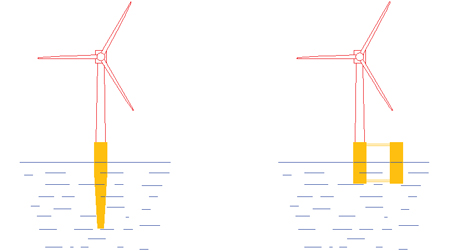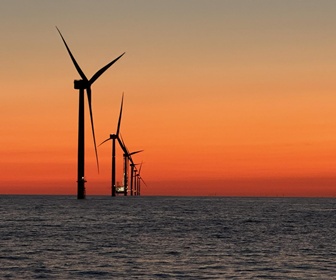 Tracing curiously the case of Siemens wind turbines in Hywind wind farm to see what the problem has been, requiring major repairs, I could not find any official statement in Equinor or SGRE websites. Obviously companies do not like to talk about their product failure or deficiency. Just recently I learned (1) that the “heavy maintenance” work included replacement of the main bearing(s). Certainly, this has not been the only repair.
Tracing curiously the case of Siemens wind turbines in Hywind wind farm to see what the problem has been, requiring major repairs, I could not find any official statement in Equinor or SGRE websites. Obviously companies do not like to talk about their product failure or deficiency. Just recently I learned (1) that the “heavy maintenance” work included replacement of the main bearing(s). Certainly, this has not been the only repair.
By Ahmad Hemami, McGill University, Montreal, Canada
The five 6 MW Siemens SWT-6.0-154 in the first floating wind farm have a rotor diameter of 154 metres, they do not have a gearbox and use a permanent magnet synchronous generator (PMSG). The foundations are spar type, extending 80 metres below the water level and attached to the seabed by three mooring points. The longest setup – from spar-base to maximum blade tip height – is 258 metres.
Without doubt, the selection of this turbine for the first floating wind farm has been based on careful studies and a proven record by demonstration of the reliable performance.
In fact, based on a 2021 report (2) Equinor’s Hywind Scotland floating offshore wind farm achieved the highest average capacity factor (54% compared to 40% record) in 2021 for any UK wind farm (the capacity factor is the ratio of the actual energy output over the maximum possible output, during a period).
In addition to the main bearing replacement, it can be envisaged that the repair work included fixing the damage to the blades. After all, the blades of a wind turbine undergo a lot of stress in their operation, and they are the weak component after the gearbox (in turbines with a gearbox). In particular, the weakest points of a blade (on the leading edge) are subject to more severe load effects.
As has been the normal practice so far, the blades are made up of two half blades that are joined (glued) together along the leading edge and the trailing edge. This immediately represents the fact that the weaker parts of a blade are its edges. The leading-edge bears all the impacts from debris in the air and hale, snow and rain drops.
For example, even at a lower speed of 6 rotations per minute, a point on the blade leading edge at 50 metres distance from the axis of rotation receives an impact from a 1 gram rain drop equivalent to a blow by a 0.5 kilogram hammer hitting the blade surface with 1 metre per second velocity.
In this sense, although the air in offshore wind farms can be free of dust (?), knowledge about the frequency and duration of rain/snow falls in an offshore wind farm can be helpful in realising the potential effect on the longevity of the blades. I believe that if the same technique is continued for blade manufacturing, eventually the blade leading edge will be covered by a metallic cover, at least for part of the blade, even if it adds to the blade weight.
In the past, a great deal of research has been carried out on studies for gearbox failure and the analysis of wind turbine gearbox loads. Likewise, but to a lesser extent (3), the analysis of forces acting on the main bearing has been the subject of extensive investigation. Even if the gearbox is removed from many wind turbines, the main bearing (one or two) is an essential component that must flawlessly function for healthy operation of wind turbines. It is the heart of every rotor in wind turbines.
According to (3) the axial loads on the main bearing are most sensitive to mean wind speed and there is a high variability in main-bearing loads in the range of wind speeds for a turbine’s operation. Also, load characteristics differ significantly for different main-bearing types.
Indeed, the thrust from wind on the rotor is to be taken by the main bearing. In this respect the bearing manufacturers try to respond to the high requirement for main bearings when designing their product. They aim to come up with an optimal drivetrain based on extensive tests. However, it seems that the loads on the main bearing are site specific and are influenced by the wind conditions at any specific wind farm site.
The turbines used in the Hywind farm have served in many other wind farms with fixed foundations, without facing the unexpected problem. As such, in addition to all other technical issues a solution may lie in changing the type of foundation (Figure 1).
Further Reading
- Stas Margaronis, Jul 08, 2024, “Equinor says Scotland floating wind turbine flaw has been repaired”: https://www.ajot.com/insights/full/ai-equinor-says-scotland-floating-wind-turbine-flaw-has-been-repaired
- https://www.windtech-international.com/projects-and-contracts/hywind-scotland-reaches-capacity-factor-of-57-1
- Edward Hart et al,” Wind turbine main-bearing loading and wind field characteristics”, University of Strathclyde, Glasgow, UK: https://pure.strath.ac.uk/ws/portalfiles/portal/88240190/Hart_etal_WE2019_Wind_turbine_main_bearing_loading_and_wind_field_characteristics.pdf








